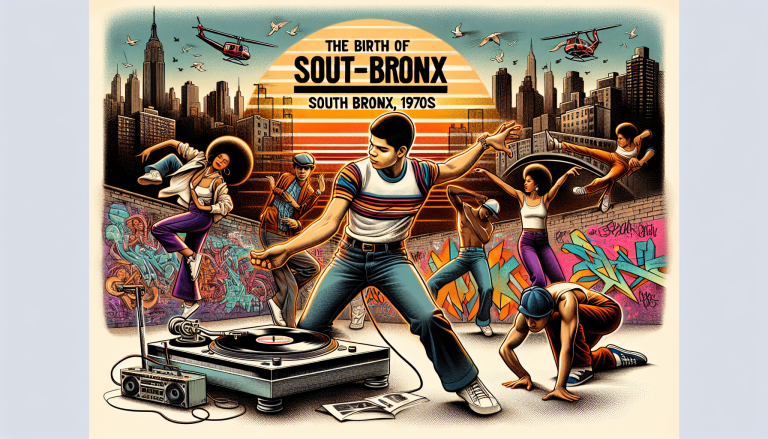The Genesis of Hip-Hop: More Than Just a Beat
Let’s take a wild ride back to the South Bronx in the early 1970s, where hip-hop was born not just as music but as a cultural revolution. Picture block parties rocking entire neighborhoods, fueled by the raw energy of young DJs spinning vinyl with twisty techniques on turntables. This wasn’t just about beats—it was a fearless form of expression bubbling out of socio-political struggles, a creative fight against the system. DJ Kool Herc, often crowned as the “Father of Hip-Hop,” pioneered the breakbeat technique by looping funky percussion sections, giving birth to the foundation on which hip-hop would build its sonic empire. This period wasn’t about shiny production or slick marketing; it was an underground movement where rhythm met rebellion and identity.
What Makes Hip-Hop Hip-Hop?
Hip-hop is its own living, breathing organism, defined by four pillars: DJing, MCing (rapping), graffiti art, and breakdancing. At its core, it’s rhythm-driven American music fused with storytelling, poetry, and attitude. Those infectious beats? Crafted from drum machines, sampled funk, soul, and disco records, and later bridged with electronic elements. The lyricism often reflects urban realities, personal triumphs, community narratives, and social commentary, making hip-hop the voice of marginalized youth turned global powerhouse.
Unlike some genres that stay locked inside studio walls, hip-hop thrives on live interaction. The battles, cyphers, and freestyle sessions aren’t just showmanship—they’re a spiritual collision of creativity and competition. The music’s meter syncopates with street vernaculars; the rhythm is an uplift wrapped in grit.
Trailblazers and Iconic Architects
Hip-hop exploded in the late 1980s and early 1990s with notable artists who transformed it from underground innovation to mainstream phenomenon. Run-D.M.C., the pioneering group, got the party jumping by merging rock with rap — remember the iconic “Walk This Way” collaboration with Aerosmith? This was the moment hip-hop bounced off urban streets and blasted into American music’s collective psyche.
The late ‘80s also saw the rise of Public Enemy, wielding razor-sharp political lyrics that challenged systemic injustice. Chuck D’s commanding flow and the Bomb Squad’s dense, sample-heavy production created a revolutionary soundscape that still resonates.
Then there’s Tupac Shakur and The Notorious B.I.G., two titans whose stories of struggle, fame, and tragedy sculpted hip-hop’s emotional depth. Albums like “All Eyez on Me” and “Ready to Die” didn’t just produce platinum records—they captured the complexities of life in vivid rhyme and raw beats.

Fast forward to the 2000s and beyond, and artists like Jay-Z, Missy Elliott, Kendrick Lamar, and Nicki Minaj have each molded hip-hop’s evolving landscape. Kendrick’s “To Pimp a Butterfly” blends jazz, funk, and hip-hop with searing social narratives—integrating rich American music traditions into modern statements.
Milestone Tracks and Albums that Defined an Era
“Rapper’s Delight” by The Sugarhill Gang may not be the first hip-hop song, but it’s undeniably the spark that propelled the genre into popular consciousness. Its catchy bass lines and playful rhymes made hip-hop accessible nationwide.
Grandmaster Flash and the Furious Five’s “The Message” broke boundaries by transforming party grooves into powerful social critique with lyrics like, “Don’t push me ‘cause I’m close to the edge.” This wasn’t just dance music any longer; it became a mirror reflecting systemic urban struggle.
Albums like Nas’s “Illmatic” raised the bar for storytelling in hip-hop, renowned for poetic lyricism and production mastery, while Outkast’s “Aquemini” blended southern soul, funk, and psychedelic vibes proving hip-hop’s versatility knows no bounds.
In recent times, Cardi B’s explosive “Invasion of Privacy” and Travis Scott’s atmospheric “Astroworld” mix aggressive club-ready trap beats with seductive storylines, illustrating the genre’s adaptability and club scene dominance.
Hip-Hop’s Echoes: From Streets to Global Dance Floors
Hip-hop’s influence travels far beyond any neighborhood corner. It has seeped into every crevice of American music and beyond, transforming the global soundscape. The dance music scenes in particular have absorbed hip-hop’s beat-centric ethos and storytelling flair, creating seamless blends where electronic dance music (EDM) and hip-hop collide. DJs worldwide sample hip-hop beats to fire up club nights, while some producers remix rap verses over dizzying synths and pulsating bass—proving the dialogue between these genres is electric.
Beyond music, hip-hop has shaped fashion, language, and digital culture. It’s spurred movements in visual art and even filmmaking. The genre’s enduring legacy lies in its unparalleled ability to empower, entertain, and express with authenticity.
Renowned author Cornel West once said, “Rap music is something that blacks can be proud of. Like jazz, opera, and blues.” It’s a proud testament that hip-hop is not a passing fad but a profound cultural force, continually reinventing the narrative of American music.
So next time you’re on the dance floor, feeling the pulse, remember: whether you’re bobbing your head to a classic breakbeat or vibing with the latest EDM fusion, hip-hop’s heartbeat is there, an unrelenting pulse that fuels the party and tells our stories in rhythms and rhymes.